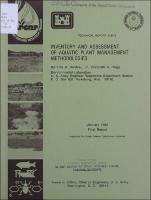Please use this identifier to cite or link to this item:
https://hdl.handle.net/11681/6388Full metadata record
| DC Field | Value | Language |
|---|---|---|
| dc.contributor.author | Dardeau, Elba A. | en_US |
| dc.contributor.author | Hogg, Elizabeth A. | en_US |
| dc.creator | Aquatic Plant Control Research Program (U.S.) | en_US |
| dc.creator | Environmental Laboratory (U.S.) | en_US |
| dc.date.accessioned | 2016-03-23T19:55:15Z | en_US |
| dc.date.available | 2016-03-23T19:55:15Z | en_US |
| dc.date.issued | 1983-01 | en_US |
| dc.identifier.govdoc | Technical Report A-83-2 | en_US |
| dc.identifier.uri | http://hdl.handle.net/11681/6388 | en_US |
| dc.description | Technical Report | en_US |
| dc.description.abstract | Native and exotic aquatic plants that adversely impact the major uses of the Nation's water resources are referred to as problem species. Operations personnel in Corps of Engineers (CE) Districts are responsible for managing the unchecked growth of these problem plants. Because the public has placed increased pressure on the CE to control problem species, these Districts need documentation of suitable management methods to develop and implement their own programs. This report documents and assesses available methodologies based on an inventory of current (since 1970) literature and a telephone survey of 14 CE Districts with active or recently active aquatic plant management programs. Although both surveys addressed all five elements of a successful aquatic plant management program (i.e., monitoring, reporting, treatment, public awareness, and training), considerably more information was found on treatment than on any of the other management elements. Both surveys yielded some information on monitoring methodologies but very little information on reporting, public awareness, or training. Although some of the aquatic plant management methodologies discussed in this report, especially in the area of monitoring (e.g., biomass sampling techniques), are only secondarily oriented to District operations programs, most have direct applicability to current District needs. These are, however, intermediate products of the research and development of "off-the-shelf" field methodologies. This report also contains a listing of important problem aquatic plant species (Appendix A), and the questions and responses of the 14 CE Districts surveyed by telephone (Appendix B). | en_US |
| dc.description.sponsorship | Aquatic Plant Control Research Program (U.S.) | en_US |
| dc.description.sponsorship | United States. Army. Office of the Chief of Engineers | en_US |
| dc.description.tableofcontents | Preface.....................................1 Conversion Factors, U. S. Customary to Metric (SI) Units of Measurement.....................................5 Part I: Introduction.....................................6 Background.....................................6 Rationale.....................................7 Purpose and Scope.....................................9 Approach.....................................9 Part II: Monitoring.....................................12 Ground Surveys.....................................12 Remote-Sensing Surveys.....................................15 Responses of the CE Districts.....................................17 Part III: Reporting.....................................18 Monitoring Element.....................................18 Treatment Element.....................................18 Part IV: Treatment.....................................22 Chemical.....................................22 Mechanical.....................................26 Biological.....................................30 Environmental Management.....................................34 Integrated Treatments.....................................36 Part V: Public Awareness.....................................39 EA's and EIS's.....................................39 Public Meetings.....................................40 Publicity Campaign.....................................40 Part VI: Training.....................................41 Aquatic Plant Management Concepts.....................................41 Aquatic Plant Identification and Population Dynamics.....................................42 Monitoring Techniques.....................................42 Treatment Methods.....................................43 Responses of the CE Districts.....................................45 Part VII: Summary.....................................46 Literature Survey.....................................46 Telephone Survey.....................................46 References.....................................48 Bibliography.....................................55 Tables 1-4 Appendix A: Important Problem Aquatic Plant Species.....................................A1 Appendix B: Telephone Survey of 14 CE Districts.....................................B1 | en_US |
| dc.format.extent | 89 pages/27.56 MB | en_US |
| dc.format.medium | en_US | |
| dc.language.iso | en_US | en_US |
| dc.publisher | U.S. Army Engineer Waterways Experiment Station | en_US |
| dc.relation | http://acwc.sdp.sirsi.net/client/en_US/search/asset/1043790 | en_US |
| dc.relation.ispartofseries | Technical Report (Aquatic Plant Control Research Program (U.S.)) ; no.Technical Report A-83-2 | en_US |
| dc.rights | Approved for public release; distribution is unlimited | en_US |
| dc.source | This Digital Resource was created from scans of the Print Resource | en_US |
| dc.subject | Aquatic plant control | en_US |
| dc.subject | Management methods | en_US |
| dc.subject | Operations research | en_US |
| dc.subject | Environmental management | en_US |
| dc.subject | Aquatic Plant Control Research Program (U.S.) | en_US |
| dc.title | Inventory and assessment of aquatic plant management methodologies | en_US |
| dc.type | Report | en_US |
| Appears in Collections: | Technical Report | |
Files in This Item:
| File | Description | Size | Format | |
|---|---|---|---|---|
| TR-A-83-2.pdf | Technical Report A-83-2 | 27.56 MB | Adobe PDF |  View/Open |